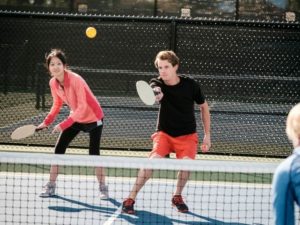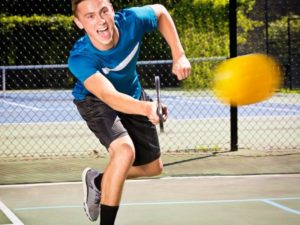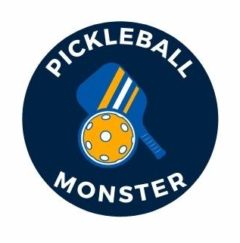Pickleball Strategies
Pickleball, like any other sport, necessitates the use of techniques in order to improve and excel in it. It’s always good to have strategies with you to win every game, whether you’re a professional or you’ve just learned how to play pickleball.
Here at Pickleball Monster, we’ve combined our pickleball tips for singles and doubles. You may rest guaranteed that the following pointers will come in handy during your next match. It just requires preparation and agreement between both players on when and how they will move around the court, as well as basic shot selection depending on both players’ skills.

Always Be Prepared
Pickleball is a fast-paced sport that can quickly transition from a sluggish dink rally to rapid-fire volleying. That’s why, especially in the kitchen, it’s critical to stay involved in the topic and keep your paddle up and ready.
You’ll have to experiment to determine what works best for you when it comes to the paddle ready position. The main points, however, remain the same:
- Maintain a straight back and bowed knees.
- Keep your paddle at about chest height.
- Rather than being tucked in, make sure your paddle is out in front of you.
Keep Serves Deep with Good Pace
If possible, always serve deep. One of the fundamental tactics in pickleball is to go get the net, so by serving deep, you can help drive your opponent back as far as possible. Vary direction, but make sure they’re in bounds.
This can help set up a weak return, making it easy for the serving team to hit a drop shot and get to the kitchen line.
Rather than Staying Back, Quickly Approach the Non-Volley Line
All of the action takes place on the non-volley line, which allows you to get to the ball faster. This allows you to use some of your methods without wasting time waiting for the ball to bounce or trying to catch it. This takes considerable expertise and self-control, but if you hit the ball too hard, it will go out of bounds. It will launch into the net if you hit it too softly.
Become an Expert in Various Pickleball Volleys
Given these various volley placement tactics, certain types of volleys are more effective than others in that scenario. There is no one-size-fits-all volley that should be used in every circumstance. Rather, the style of volley you execute is determined by your court placement, the height of the ball in relation to the net, and your volley goal.
Pickleball volleys can be classified into three categories:
- Dink Volleys
- Punch Volleys
- Roll Volleys (Topspin Volleys)
- Drop Volleys (Block Volleys)
- Punch Volleys

Pickleball Strategies
Make a Shot Selection Decision and Stick to It
On the pickleball court, making decisions is crucial. Winning or losing a pickleball game is largely determined by shot selection, playing greater percentages, and determining where to position yourself on the pickleball court. That being stated, it is critical to make timely judgments and stick to them.
For example, if you want to force a backhand shot, aim your return shot at your opponent’s left foot. A deep backhand shot that falls on their left foot makes the serving team’s drop shot more difficult to perform. This strategy works regardless of whatever side the serve comes from, as I previously stated.
Master Third Drop Shot
You’ve probably heard of the ‘third shot drop’ if you’ve been playing pickleball for a while. While it isn’t your only option, the third shot drop is one of the most important shots in pickleball and should be in the arsenal of any serious player.
Keeping the ball down or low is the key to any third shot. Because your opponents will most likely already be at the no-volley zone line, this is a good idea.
This shot is crucial since it limits your opponent’s ability to attack the ball while also allowing you to move to the kitchen line.
Keep in mind that a drop shot can be made at any time during a game. If you ever find yourself out of position and need to ‘reset’ the point and get back into place, this is an excellent choice.
Be Prepared for the Slam
Keep an eye out for your opponent’s paddle being pulled all the way back behind them for the wind-up before the slam. This is your cue that they’re going to hit the ball hard, giving you a few extra milliseconds to prepare and position yourself.
Place Your Shots Well Rather Than Hitting the Ball Hard
According to an established tournament pickleball player and instructor, errors account for 75% of rallies won (or lost); only 25% are earned or won by a good shot. You can do this by just maintaining possession of the ball. The doubles team with the fewest unforced errors has the best chance of winning.
Rather than attempting to strike a player on every shot, it is preferable to control the ball and allow the opponents make the mistake, or to wait for a chance to shoot a guaranteed winner.
In doubles, the safest position to hit a ball is deep down the middle; this reduces the possibilities of striking wide and may cause confusion about who should return the ball.

Learn Dink at the Net Strategies
Don’t just dink for the sake of dinking when playing the soft game in the kitchen. We dink for two reasons: to keep shots unassailable and to throw your opponents off balance or out of position.
Here are some additional internet snooping strategies:
- Always keep the ball as low as possible while at the net. Maintaining a low ball position prevents your opponent from attacking.
- Dink carefully. Don’t make things too difficult for yourself. Keep the ball in play by playing it safe and hitting high-percentage shots.
- When you’re at the net, hitting high to low is good. This enables you to play more aggressively and score more points. It’s not a good idea to go from low to high. This gives your opponent a “attackable ball.”
Communicate with Your Partner
For doubles pickleball, one strategy that is key to winning pickleball is strong communication with your partner. You and your partner should communicate during a rally and between shots.
For instance, communicating who takes pickleballs that land in the middle, who is running down the lob, and whether or not to let certain shots go by that will be landing out of bounds—“Out” or “Bounce It!”
You and your partner should also communicate with each other between points. For instance, should your strategy change, or are one of you seeing a weakness in your opponents.
Lastly, you and your partner should also communicate to encourage each other such as saying “Nice shot!” and “Let’s go!”
You and Your Partner Should Move in Unison
Partners should constantly move up and down, as well as side to side. Because the court is so small, no volleying is allowed within the seven-foot non-volley zone. This stops players from closing the net. This encourages players to use drop volley or “dink” shot methods, in which they hit shots over the net that land in the non-volley zone, sometimes known as “the kitchen.” If the ball bounces in the kitchen, a player can walk into it and knock it over.
Some pointers: Keep your pickleball paddle high and centered to your chest while waiting for the ball so you’re ready for a shot from either side. Keep your eyes peeled for the following shot. Keep the ball in play and wait for your opponent to make a mistake.
Use Good Equipment and Dress Appropriately
Make sure you’re wearing the right tennis shoes before you step onto the court, whether it’s indoors or out. Your shoes should have a flat, sturdy sole, non-marking soles, and provide stability for side-to-side movement. Bring some water with you to stay hydrated.
You should not use a paddle that is overly hefty. Look for one that provides both touch and power. With some padding, the grip should feel comfortable in your hand. You can always re-wrap your grip or add a thin over grip to make it more comfortable. Remember to write your name on your paddle as soon as possible. Singles, doubles, and mixed doubles are all options. When you play with players that are equally skilled as you, you will have plenty of competition and a lot of fun. This sport is enjoyed by people of all ages.
